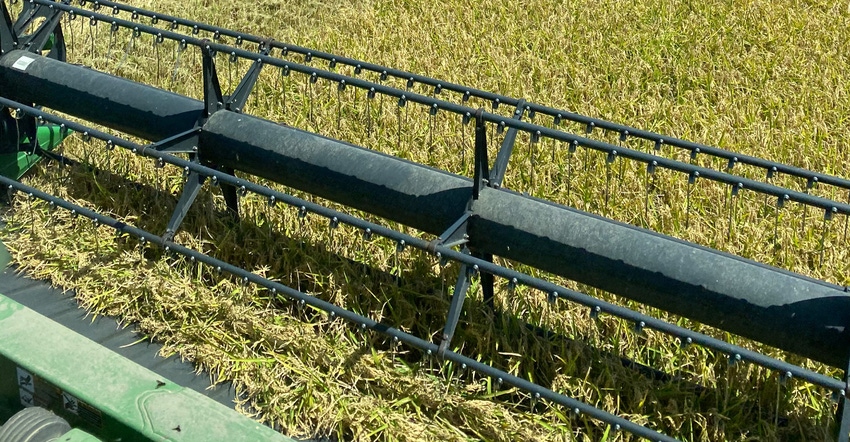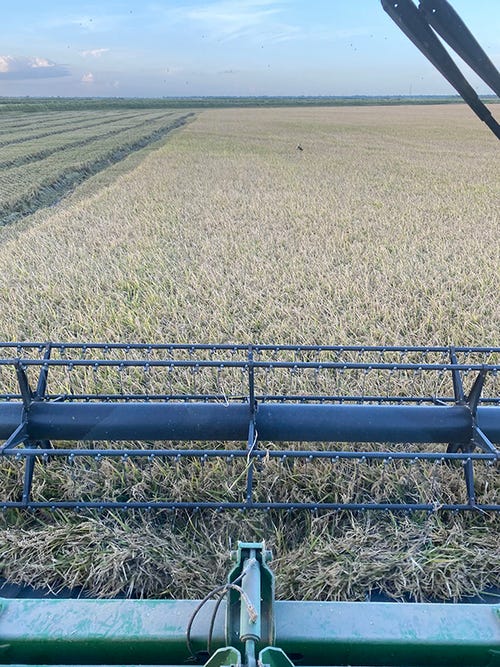
It’s been a good year for Texas rice with yield estimates topping 7,800 pounds per acre, dry, on the main crop.
“It’s been a very good year for rice yield,” says M.O. Way, professor of entomology, Texas AgriLife Research and Extension Center, Beaumont.
“We still don’t have reliable yield data, but average yield should be better than 7,800 pounds per acre on the main crop. The ratoon crop is also looking good, but recent cool weather may negatively affect the second crop.”
Jefferson County farmer Chris Latta says his crop is “just okay. Yields run in the low- to mid- 50s per acre on a green basis. Milling yield is also down,” Latta says.
 (Texas rice acreage should remain stable in 2021, “unless other commodity prices go way up,” says El Campo, Texas rice farmer L.G. Raun. Photo by L.G. Raun.)
(Texas rice acreage should remain stable in 2021, “unless other commodity prices go way up,” says El Campo, Texas rice farmer L.G. Raun. Photo by L.G. Raun.)

He’s not certain why milling yield is down but says it could be from showers at bloom. “But we didn’t get high winds with the rain; that’s what usually affects milling yields.”
Harvest conditions were good. “We had dry harvest weather. Moisture dropped drastically as we began harvest, from 18% to 20% when we started down to 13% to 14% when we got through.”
Latta says he’s not sure how his ratoon crop will turn out.
Okay yields
L.G. Raun, El Campo, says his main rice crop looked good before harvest, “but was not what we hoped for. Yield is above average but is not what we expected. The ratoon crop also looks good, but we will not know how good it is until we get the combine in.”

He’s also concerned that storms building in the Gulf of Mexico can threaten the second crop. “We’re keeping an eye on two storms building in the Gulf now.”
Latta says markets are good, unusually so for this time of year. “Price usually tanks at harvest. But exports are up, and imports are not flooding the market. Price is around $13.”
Weedy rice
He’s concerned about increasing difficulty controlling weedy rice. “We’ve had a big problem, similar to what we used to have with red rice.”
See, Rice market volatility: ‘get used to it’
He says herbicide resistance seems to be part of the problem. “And in recent years, all the water we’ve had seems to make it worse. We’ve tried different tillage methods, water seeding and other measures — similar to what we did with red rice infestations. We need a new herbicide and variety to help us control weedy rice.”
Latta says weedy rice “has characteristics similar to red rice, but it seems to be more vigorous. It comes on quicker.”
He says red rice almost put a lot of producers out of business back in the ‘90s, before Clearpath herbicide came along.
“In 1996, we cut and baled rice because of so much red rice infestation. Clearpath saved us when other control measures stopped working.”
He says weedy rice is an issue across the Rice Belt. “The technology is out there,” he said. “We expect new chemistry in 2022. We hope we can hold on that long.”
In addition to rice, Latta grows hay and raises cattle.
Usual challenges
Way says rice producers experienced the usual challenges in 2020. “Disease problems have been minimal, but we’ve seen some kernel smut. We’ve also had some complaints about low head rice yield, associated with very high yields.
“Insect pressure from rice water weevil and rice stink bug has been average or greater than average. Virtually all our rice farmers apply an insecticide treatment. Treatment of choice is Dermacor X-100, which controls both rice water weevil and stem borers.”
He says most farmers also apply Tenchu 20SG for rice stink bug control. “This product has good residual activity, so many farmers are only spraying once, sometimes twice for this pest.”
Way says rice planthoppers have shown up in some fields. “Either populations are low, or farmers have sprayed with Endigo ZC.”
A new wrinkle showed up late, he says. “Late in the main crop season, some farmers were reporting damage from the English grain aphid, which is a new one on me.”
Hurricane impact
He says overall damage from Hurricane Laura has not been significant.
“As far as I know, we’ve had no direct loss of rice to Laura, but the impending rain caused farmers to harvest rice before fields were dry, which rutted up the fields affecting ratoon crop production. Some rice lodged here at the center, but I don’t think any (or on a very small number of acres) lodged commercially.”
Latta says the hurricane affected less than one-third of his main crop. Most was harvested before the storm hit. “We had some shattering but not a lot blown down.”
Way says the 2020 Texas rice crop totals about 180,000 acres.
That’s an improvement over 2019, Raun said. “Texas rice acreage was down to 153,000 last year. We’re back to 180,000 this year and that’s been pretty stable.”
Those numbers pale in comparison to the 500,000 acres Texas farmers once planted.
Raun says acreage has dipped in East Texas where farms compete with urban encroachment and industry for land and water.
Raun’s family has grown rice in the area since 1915, when his grandfather planted his first crop. Now, he, his wife, Linda, his brother and nephew are the only Rauns still growing rice.
He thinks Texas will plant about the same acreage next year. Further acreage declines will affect the infrastructure necessary for a rice industry.
“Prices are a bit flat, now,” Raun says. “They might be marginally better, and futures are up a bit. Still, I think Texas will plant about the same acreage next year unless the price of other commodities go way up.”
Read more about:
RatoonAbout the Author(s)
You May Also Like






